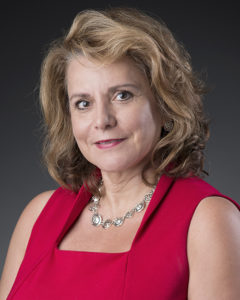People, the Key to Successful Change
Benjamin Franklin famously said, “…in this world nothing can be said to be certain, except death and taxes.”
Today, we’d add change to that list.
Every modern organization faces some degree of change, and sometimes has an entire department devoted to managing it. Recent history shows that organizations that don’t adapt to change often don’t survive.
Yet, experts estimate anywhere from 50 to 70 per cent of change initiatives ultimately fail. However, increasingly, people are identifying and isolating what makes change successful.
From 2012 to 2014, Eduarda Hodgins served as the director of organization development and change management at the Insurance Corporation of British Columbia (ICBC). Today she’s director, people, culture and performance at Tapestry, a division of Concert Properties Ltd.
While at ICBC, she led, “a change that turned the organization upside down, sideways and backwards,” she said. The corporation introduced new software that had more than 100 integration points, changed long-established processes, protocols, jobs, responsibilities and organizational hierarchies, and affected 5,000 employees as well as external groups.
“It changed the organization in a profound way. It went beyond a system change. It changed how we interacted with customers, each other, partners and suppliers, and how we changed our service model. It was extraordinarily difficult to accomplish it without significant interruption to our customers and the ongoing business.”
Hodgins’ background as a communications professional prepared her well, she said. “It’s all about enabling the people side—the human side of change. We were constantly looking at groups’ different characteristics and needs to find out how we could best communicate with each of those audiences.
“Change is often to inform or change an opinion—without calling it change management, we’ve been doing it for years. I was fortunate that this experience gave me the opportunity to learn and formalize my methodology.”
Planning Effective Change
Hodgins learned that there are common elements required to make change successful, whether small or transformative. “You can’t shortcut these things,” she warned, listing:

Eduarda Hodgins
- Determining and understanding the case for change—why is your organization doing it?
- Defining who your various stakeholders are and how they’ll be impacted by the change.
- Planning how to prepare your stakeholders, using different avenues to ensure messaging gets to them.
- Cultivating critical leadership support.
- Effectively managing the change as it’s occurring and after it’s implemented.
“Regardless of its size, it’s a process,” she said, “and any change I’ve led, I’ve approached the same way, considering the same fundamental elements.”
HR’s Role in Implementing Change
“Good change management is all about the people side of change,” Hodgins added.
Aman Malhi, currently director, people and culture, at The Flowr Corporation in Kelowna, led a significant cultural change at a previous employer, a long-established company with more than 200 employees in three locations in Canada.
“There was a traditional top-down culture and decision-making process, which was a mismatch with who we were hiring—mostly millennials. It seemed ineffective to them. They also couldn’t align with existing strict policies, for example, that everyone had to work set hours, in the office.
“We needed to change how we recognized our top performers. Our bonus plan was very outdated; it only measured corporate performance, not an individual’s, and people felt they had no control over the bonus they were making. We also didn’t have an RRSP program or any other measures to help employees with saving.”
The HR department conducted research and heard what employees needed in exit interviews, employee surveys and even in recruiting interviews. “The biggest thing was recognizing the gap, creating awareness of what was missing and why we needed to make changes,” Malhi said.
“In my experience, members of the C-suite are very much focused on their specific areas of expertise. Recognizing the gap between being a decent place to work and being an amazing place to work is entirely on the HR team.”
Ongoing Research a Basis for Success
HR should be able to recognize employee needs because it has a responsibility to monitor how things are going all the time, not just during change, Malhi added. “Lots of HR teams rely heavily on employee engagement surveys and more structured ways of getting feedback, but connecting with people outside those structured ways is so important.
“Every two weeks, I hold a coffee session—very informal, low-key, in a lunch room, where I bring coffee and treats—where people are welcome to come in and talk about what they want to talk about. What

Aman Malhi, CPHR
I’ve learned is invaluable. Employees ask questions about what the company is doing and why, and I can build informal teams and bonds. Getting creative about how you collect feedback from your employees is what HR should be doing all the time.”
The first step before doing anything is understanding why you’re doing it and what the need is, Malhi said.
“You need to really understand who your stakeholders will be, what you’re trying to accomplish and for whom. Then, put together a plan based on the vision, how you’re going to communicate it, how you’ll work through organizational politics. And have a contingency plan, because there will always be some things that don’t go as you expected.
“For most change management processes, you only get one chance. You don’t have to get it 100 per cent right, but if you get it wrong in a massive way, people get a negative mindset that is very hard to change. You always have to remember you’re not going to get multiple chances.”
Changing Organizational Procedures
Even what may seem like common-sense procedural change needs to be managed. Jaiveer Singh Pahwa is a recruitment consultant who spearheaded major changes in Fraser Health Authority (FHA) recruitment practices.
“We were doing it mainly for hard-to-fill positions,” he said. “We need a lot of physicians and nurses, and we don’t have the depth of talent in Canada to fill all the vacancies.”
By changing tactics, FHA reduced its average time to fill a position from 200 days to 50-to-60 days.
“We have put more focus on using LinkedIn, Indeed, Facebook and Instagram,” Pahwa explained. “Instead of just posting a job, it’s best to have testimonials from the same department, telling potential applicants why someone should join FHA and that team—so they can clearly see the vision and think, ‘I want to be like that person.’ Videos are our preferred tool. People connect more, get more relevant information and retain it better.”
Once results became evident, reaction was positive, he added. “Team management loves it. Other departments at other hospitals are adopting the same practices. We never had a position for marketing recruitment, but now we have created one.”
There was definitely pushback when he first suggested the new ways to approach recruiting. As is often the case, the workforce was reluctant to change, wanting to do the same screening and posting they had always done.
“We had to explain that now we’re living in a digital world and we have to get out there or other health authorities will take our talent,” he said.
Initially, departments were uncomfortable with the less formal language and increased emphasis on the organizational reputation. There wasn’t much response to requests to current employees for testimonials to use in recruiting; people didn’t want to put themselves forward.
“We had to convince them sometimes, say this is good for your teams and will help fill the positions. We made up a dummy ad to show them what we envisioned.”
Ultimately, results overcame resistance.
Change From the Ground Up
Sometimes change isn’t just altering existing processes or culture, it’s creating them. Currently a human resources consultant at Vancity Credit Union, Jasdeep Dhaliwal was heavily involved as an HR advisor at the British Columbia Liquor Distribution Branch in the establishment of its cannabis division.
“The biggest difference between the LDB’s existing business was that it was mature, in operation for 98 years, while ours was brand new,” she explained. “Working for a start-up, which is how the cannabis operations division operated, was far different than working for an established organization such as the liquor side.”
They also faced a tight government-set timeline—nine months from appointing the LDB as the official cannabis distributor in B.C. until it had to be selling product.

Jasdeep Dhaliwal, CPHR
Other factors beyond their control included individual policies that varied between municipalities, and competing against the black market selling similar products.
They began by looking at the LDB’s existing purpose, vision and service model, and deciding what to keep and what to change.
“There was a lot of push and pull at the leadership team level,” Dhaliwal said. “The executive director of the cannabis division had to explain why we wanted to do things differently, and how that would be better for this line of business. We wanted to leverage and align the LDB’s established values for cannabis operations.”
“We had the opportunity to plant the seeds of the culture we were wanting to cultivate for cannabis operations,” she added. “It was imperative that we did this from the beginning.”
Within that challenge, flexibility was key and hiring the right people was paramount. “Individual responsibilities changed more frequently. Individuals were required to find their own solutions to problems presented to them from resources provided.
“Individuals were not managed closely, and it was apparent that everyone hired was trusted to take ownership of the scope, work cohesively with team members and deliver results. Everyone who was hired needed to be really open in sharing information, not assuming that people were going to come to them with the information they required.”
The result was a dedicated, highly functioning program that was clear on what needed to be done, Dhaliwal said.
“The team consisted of passionate, deeply committed, hardworking individuals. Empowering them and expressing gratitude went a long way. We had to embrace flexibility, adapt to ever-changing circumstances, take on more when needed, and be careful not to get stuck in old ways.
“In short, we looked for people who were curious, deeply passionate about the cannabis space, whether the social responsibility aspect or the cannabis product, and individuals who were nimble, flexible and digital thinkers in an ever-changing environment.”
Leadership Buy-in Is Key
For any change initiative to be effective, leadership support is vital as employees notice what leadership says, does and supports.
“Success is inextricably linked with the effectiveness of your leadership and their understanding of their critical role in change,” Hodgins said, adding that leaders are one of the most critical factors in the success of any change initiative, because of their important role in terms of what they express, model and reinforce.
“I’ve seen situations where leaders weren’t going to show up the way they needed to, like planning their vacation for go-live date. Employees need to know leaders will be on the ground to support the change, will be first in line for training, have their backs and understand the importance of the change.”
Malhi agreed. “You need to bring the executive team, C-suite and board into the loop and get their buy-in,” she said. “Talk about the return on investment, make sure what you’re working on is actually aligned with the organization’s vision and that it’s what employees need.”
She also found it useful to “compare what we were trying to accomplish and wanted to change with our competition with similar revenue, head count and industry. We took that information to the employees as well, sharing it at townhall meetings and in the CEO’s monthly communication.”
Build a Team
While the scope of change initiatives varies widely, successful implementation requires a team that encompasses more than leadership and human resources.
“Change management has always been partnered with HR and communications, not trying to duplicate their abilities but to use the talent that already knows their role in the organization,” Hodgins said. “Leverage the talent that already exists. If a change will impact union issues, draw in the employee relations team to leverage their experience and talent to work through it.”
Pahwa echoed that advice. “Look at your organization’s resources, what you have in hand. Recognize that there’s always a difference between important and urgent. Change must have organizational

Jaiveer Singh Pahwa, CPHR
resources attached to it, and you need to know the project timelines so you don’t waste resources.”
FHA’s changes required co-operation between leadership, communications, people strategies, clinical hiring managers and the employees who were asked for testimonials. “We created a dummy testimonial to show them, so they could see what we were trying to do.”
Informal team members can also play an important role.
“The one thing that I realized made a huge difference was tapping the power of hidden influencers,” Malhi said.
“For example, there was a gentleman on the IT team who was respected, a long-time employee who was sort of like Yoda for everyone. I connected with him first and got his buy-in and talked about what we were trying to achieve and how we were going to do it. We leaned on him quite a bit to create momentum, vision and get people online.
“We did the same with every department. It doesn’t even have to be someone from within that team; if it’s someone within operations, let’s say, that IT has been working closely with for years, people respect and have faith in that person. It’s really recognizing who these people are and leaning on them as much as you can.”
Change can be challenging, so don’t be afraid to ask for help. “Most HR leaders understand that change is complex and will get advice and counsel on how to put together a change plan, particularly if it’s a large people-centric change with large cultural impact,” Hodgins said.
“Sometimes you need to augment your expertise, and bring in resources and capacity to ensure the change is successful. But don’t put outsiders in charge, because you know your organization. Listen to your own instincts and trust your understanding of your organization.”
Plan to Communicate
Successful change relies on ample communication to mitigate natural fear of change and any misinformation that might be floating around, as well as to create employee buy-in.
“It needs to be a two-way process,” Malhi said. “Get creative about how you’re sharing information. I’m a huge advocate of transparent communication, I believe in its power. Tell employees, ‘These are our challenges,’ and they’ll step up to the challenge and help the company work through them. You need to have difficult conversations, regardless of what the topic is.”
Dhaliwal agreed that communication is key. “Sharing information at all levels of the organization led to a positive culture. By decentralizing management, we enabled employees to feel more comfortable and to develop strong relationships with team members as well as customers.”
It needs to extend beyond practical, organizational information, she added.
“Employee recognition, showing people that they mattered, and recognizing employee performance or team achievements—by understanding the importance of showing employees that they were appreciated, we created a culture of employee recognition, through gestures as small as a card and employee personalized emails. This went a long way in creating employee loyalty and team engagement.”
Continuous communication throughout the change can ensure success, in Malhi’s experience.
“You have to go back to those influencers and do a pulse check with them to make sure—what is the feedback you’re getting that people might not be comfortable sharing with our team or the executive? That kept us on our toes and kept us revisiting our progress,” Malhi said.
“Measure the impact and what you’re able to accomplish. Never get comfortable with the status quo. Make sure changes are still relevant and tweak or edit your plan if needed.”
Not for the Faint of Heart
“By default, people are scared of change, nobody wants to take the first step even if they know change needs to happen,” Malhi said. “If you recognize a gap and feel it needs to change, be bold. HR departments play defence most of the time, but for change management, we need to take the lead, go on offense and fight for it.
“There have been moments in my career when I brought things forward once, twice, three times and nobody paid attention, and then six weeks down the line, what I was trying to highlight happened. You need to be bold and confident, and take a stand if you believe in what you’re trying to accomplish.”
Leading change management takes a lot of courage, Hodgins added. “It can be very difficult to be in a position of having to articulate where something may not be going the way a leader wants, or that you have an issue that you might need to stop and address when there’s tremendous pressure to move the project forward.
“Be willing to have an unpopular view; accept that you won’t always be popular. You have to be ready to speak truth to power when others may not want to hear it.
“Great leaders give you the space to speak your truth.”
Nancy Painter is an award-winning writer and editor from Surrey, B.C., and a member of the Canadian Freelance Guild.
For the latest HR and business articles, check out our main page.
Reader Feedback
We want to hear from you!
Do you have a story idea you’d like to see covered by PeopleTalk?
Or maybe you’ve got a question we could ask our members in our People & Perspectives section?
Or maybe you just want to tell us how much you liked the article.
The door is always open.









